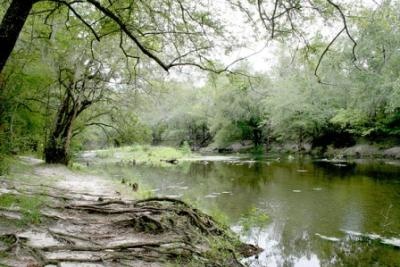Withlacoochee River Fishing Spot
- Elevation: 82'
- Last Modified By: vinny60 on 09/23/09 05:58 PM
- Ask about Withlacoochee River in our Fishing Forums
Photos

Fish Species
Comments
-
Expect sections of this river to be better than others, as water levels upstream of Rt. 200 are very low. Good fish can still be found within these reaches but navigating to locate them will be better suited for airboaters. Flowing water seems to be a real magnet for largemouth bass, panfish and catfish lately. Aggressively fished topwater baits fished at dawn and dusk will continue to be a productive means for bass. Bluegill, warmouth and redear sunfish (along with those channel catfish) will take baits fished on the bottom.
Withlacoochee River Description
The Withlacoochee River (South) originates in central Florida's Green Swamp, east of Polk City. It flows west, then north, and then turns northwest and finally west again before it empties into the Gulf of Mexico near Yankeetown. The river is 86 miles (138 kilometers) long and has a drainage basin of 1,170 square miles (3,030 square kilometers). It is believed to have been named after the river to the north. The Withlacoochee River forms most of the boundary between Polk County and Sumter County, then flows through Pasco County and Hernando County, and then forms part of the boundary between Hernando County and Sumter County, and all of the boundary between Citrus County and Sumter County, between Citrus County and Marion County and between Citrus County and Levy County (including Lake Rousseau). The largest city close to the river is Dade City. This 157-mile stream originates in Green Swamp in Hernando County and flows north to the Gulf at Yankeetown. The stream has many limerock areas and associated swamps. Water levels fluctuate except in Lake Rousseau and the area just above the influence of Rainbow River. Water color is dark during the rainy season and clear during low water. Public ramps are located at S.R. 44 in Rutland, C.R. 470 north of Lake Panasofkee, the Outlet River west of Lake Panasofkee on C.R. 470 in Sumter County, C.R. 39 north of SR 200 in Citrus County, U.S. Highway 41 at Dunnellon and SR 40 at Yankeetown.
The Withlacoochee River (South) originates in central Florida's Green Swamp, east of Polk City. It flows west, then north, and then turns northwest and finally west again before it empties into the Gulf of Mexico near Yankeetown. The river is 86 miles (138 kilometers) long and has a drainage basin of 1,170 square miles (3,030 square kilometers). It is believed to have been named after the river to the north.